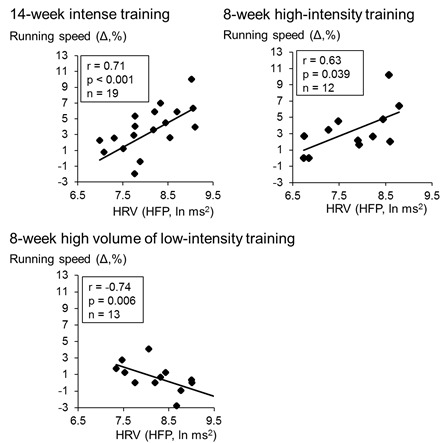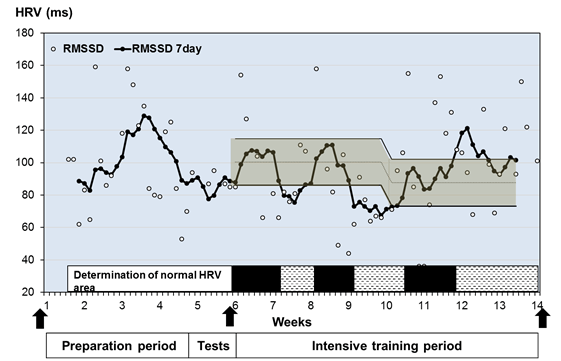
Predicting how athletes will react to training is a challenge, especially when the goal is to boost endurance performance. Similar training protocols and programming often produce different results. One athlete may successfully enhance their performance, while another may experience a performance decline. The ability to predict how a particular individual will react to a training protocol in advance is a critical step in getting training prescriptions right.
 In this blog post, exercise physiologist Ville Vesterinen, Ph.D., summarizes his exploration of the potential of heart rate variability (HRV) to inform training decisions and as a result provide better training prescriptions. A graduate of the University of Jyväskylä, Vesterinen works in the same fields of expertise that provided the basis of Firstbeat’s HRV-based innovations in physiological analytics and their application to guide real-world training decisions.
In this blog post, exercise physiologist Ville Vesterinen, Ph.D., summarizes his exploration of the potential of heart rate variability (HRV) to inform training decisions and as a result provide better training prescriptions. A graduate of the University of Jyväskylä, Vesterinen works in the same fields of expertise that provided the basis of Firstbeat’s HRV-based innovations in physiological analytics and their application to guide real-world training decisions.
Today, Vesterinen works as a researcher at KIHU – Finland’s national Research Institute for Olympic Sports – where his expertise supports the training and development of the well-respected Finnish National Cross-country Skiing team. Firstbeat analytics are a key resource in the testing toolkit of KIHU experts, who are already eyeing the 2018 Pyeongchang Olympics after helping top-skiers to a great success in 2017 FIS Nordic World Ski Championships in Lahti, Finland.
Endurance training induces many physiological adaptations, especially to the cardiorespiratory system and aerobic energy metabolism. Most training studies focus on the main effects and mean group changes. However, the results of those studies may hide a wide range of individual adaptation in response to endurance training.
Some studies report large individual differences in adaptation responses to standardized training (e.g. Bouchard & Rankinen 2001, Hautala et al. 2003, Vollaard et al. 2009). While some individuals may achieve huge improvements in physical fitness, others experience negative adaptations in response to similar training. Similar training programs are, then, not optimal for everyone, and training programs should be individualized to be more effective. To address this problem, special attention should be paid to identifying non-responders and modifying their training program.
A number of factors have been shown to be related to individual endurance training adaptation including age, sex, pre-training fitness level, and cardiac autonomic regulation (Bouchard & Rankinen 2001; Hautala et al. 2003). Nevertheless, individual trainability to different endurance training programs is still unclear.
The aim of my doctoral thesis was to explore whether a subject’s pre-training characteristics could predict individual adaptation responses to different types of training programs. In addition, the aim was to explore heart rate variability (HRV) as a tool for guiding the individualization of endurance training prescription.
My thesis was examined and accepted at the University of Jyväskylä in November 2016.
In this text, I will highlight the main findings of the thesis, which can be downloaded here.
To explore this topic, I conducted three longitudinal endurance training studies. A total of 108 recreational endurance runners, both male and female, participated in the studies.
A brief description of the studies:
- a 28-wk intense period (INT) with progressively increasing training volume and intensity (n = 28);
- an 18-wk period including either a high volume of low-intensity (HVT) or high-intensity training (HIT) (n = 40); and
- a 12-wk study with HRV guided training (n = 40). The subjects performed running tests for determining training adaptations and resting measurements, such nocturnal and morning HRV recordings, for evaluating physiological characteristics.
In terms of pre-training characteristics predicting training adaptation in the participants, nocturnal HRV was the strongest of the characteristics studied. It was negatively associated with adaptation in response to high-volume low-intensity training, and positively associated with intensive training and high-intensity training (Fig. 1).
In other words, recreational runners with lower HRV showed increases in endurance performance capability in response to prescribed high-volume low-intensity training, while participants with higher HRV responded well to high-intensity training and prescriptions that included progressively increased training volumes and intensity.
The final study targeted the potential of utilizing HRV as the basis of individualizing training prescriptions for improved endurance capability. In this study, participants were divided into two training groups. One group performed training activities prescribed on the basis of guidance from HRV values. The other group followed a predefined training program that incorporated more moderate- and high-intensity training periods compared to the HRV-guided training group (Fig. 2).
At the conclusion of the 8-week experimentation period, 3,000 meter running performance improved in the HRV-guided group, but not the group that relied on a traditional predefined training prescription approach.

Figure 1. Relationships between changes in maximal aerobic running speed and pretraining nocturnal HRV over 14 weeks of intense training, 8 weeks of high-intensity training and 8 weeks of high volume training.

Figure 2. Example of programming endurance training based on daily HRV. The grey area indicates the individual’s normal area of RMSSD. Moderate- and high-intensity training was programmed when HRV was within the normal range (the black area), otherwise low-intensity training was programmed (the dashed line area).
Previously cardiac autonomic regulation has been used to monitor stress and recovery status. The findings of my thesis suggest that training programs can be individualized based on resting cardiac vagal activity. It follows that HRV holds potential as a practical tool for a priori identification of individual trainability.
Individuals with high baseline HRV are recommended to increase training load primarily by increasing training intensity rather than training volume.
On the other hand, the findings suggest that individuals with low HRV would respond better to increased volume of low-intensity training.
Traditionally, endurance training plans and programs have been based on sports and scientific literature, general recommendations, experience of coaches and subjective feelings. Training programs are typically predetermined despite the absence of objective information regarding the athlete’s current training status and adaptations to previous training. The findings of my thesis indicate that training prescription based on the status of cardiac vagal activity represents a path towards improving endurance training outcomes.
In terms of optimization, the scheduling of vigorous training sessions based on HRV seems to be more more desirable compared to subjectively predetermined training programs. Therefore, HRV demonstrates potential as a tool for prescribing endurance training prescriptions by offering insight into the optimal timing of vigorous training sessions.
Innovative technologies offer practical and valid solutions to measure HRV and other individual physiological variables. To be effective, they should be used consistently and systematically. They should also be simple and easily interpreted to facilitate modifications in training program as needed.
References:
Bouchard & Rankinen. Med Sci Sports Exerc 33, 446-451, 2001.
Hautala et al. Am J Physiol 285, 1747-1752, 2003.
Vollaard et al. J Appl Physiol 106, 1479-1486, 2009.
If you liked this article, you should subscribe to our mailing list
You might also be interested in

Solving the Training-Injury Prevention Paradox
In August 2017, Firstbeat Sports hosted a special webinar featuring Dr. Tim Gabbett, an internationally renowned physiologist and leading expert on the topics of training demands and injury prevention.

How Loss of Key Player Increases Value of Recovery Data for Tottenham Hotspur
Training load monitoring and recovery testing are among the ways that top teams like Tottenham Hotspur are leveraging science and technology to reduce injuries and create competitive advantages on the field.

NCAA Basketball: The Practical Side of Recovery Monitoring
As part of the Firstbeat Sports webinar series, Sean Conaty of the University of Eastern Michigan delivered his insights into the practical side of using data to enhance performance for NCAA men’s basketball players.